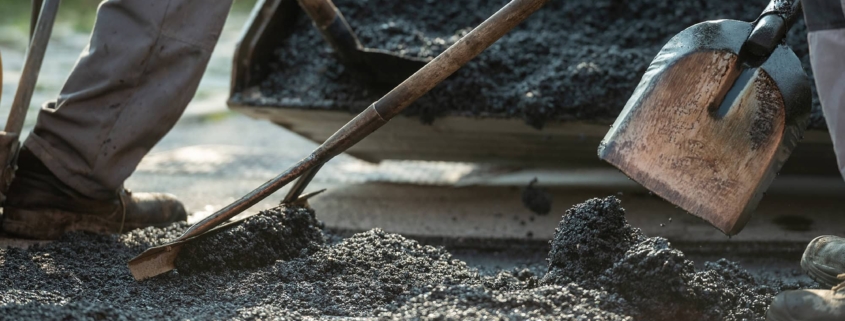The Complete Guide to Asphalt Driveway Maintenance
Like any well-used outdoor surface, asphalt is subject to the relentless cycle of the seasons and the wear and tear of daily use. Typically, a well-installed driveway can last between 12 to 20 years. However, this life expectancy is heavily dependent on the care and maintenance that it receives.
This guide explores the essentials of asphalt driveway maintenance, why it’s crucial, and discovers how simple preservation steps can keep your driveway in prime condition through the years.
The Importance of Regular Inspection and Assessment
Maintaining the longevity and aesthetic appeal of your driveway requires vigilant care, of which regular inspection and assessment are pivotal. Routine examinations can preempt the escalation of minor issues into costly repairs, ultimately saving you both time and money.
Spotting Early Signs of Wear and Tear
Early detection of wear and tear is essential in asphalt driveway maintenance. Look for fine lines, which could be the start of cracks, and small holes, which indicate the initial stages of pothole formation. Discoloration and fading can suggest drying and oxidation of the asphalt, which, if left unaddressed, may lead to brittleness and further damage.
- Examine the color and texture of your driveway; variations could foretell potential problems.
- Survey for any pooling water after rain, as this is a common cause of asphalt degradation.
- Be vigilant for oil spots or chemical spills that may break down the asphalt binder.
By conducting regular inspections and promptly addressing any issues, you can ensure that your asphalt driveway remains in top condition throughout the years.
Cleaning and Removing Stains: The First Step in Maintenance
Maintaining an asphalt driveway extends far beyond mere aesthetics; it is crucial for its longevity and performance. Cleaning and removing stains represent the foundational step in a comprehensive commercial asphalt maintenance routine. By promptly addressing contaminants such as oil, grease, and chemical spills, you can prevent them from penetrating deeper into the asphalt, where they can cause significant damage over time.
Techniques for Cleaning Oil, Grease, and Chemical Spills
Effectively dealing with spills is imperative to protect your driveway’s integrity. For fresh spills, using absorbent materials like cat litter or sawdust can help soak up the substance before it sets in. For stains that have already dried or set, power-washing with a degreaser or a specialized cleaning solution may be necessary to break down and remove the residue.
The Right Cleaning Agents for Different Types of Stains
It’s not a one-size-fits-all situation when it comes to cleaning agents for asphalt driveway stains. Here’s a quick guide:
- Oil and Grease: A degreaser or laundry detergent can be effective. Apply the cleaner, let it sit to break down the stain, and rinse thoroughly.
- Fuel Spills: These can be particularly damaging and should be handled quickly with a dedicated asphalt cleaner.
- Chemical Stains: For chemicals such as antifreeze or salt, look for eco-friendly cleaners that can neutralize and remove the contaminant without harming the asphalt or nearby plant life.
Remember, after cleaning your driveway, regular inspections will help you identify any new spots before they become entrenched, making your asphalt driveway maintenance efforts all the more effective.
Repairing Cracks: Preventing Minor Issues from Becoming Major
One critical component of asphalt driveway maintenance is addressing repairs as soon as they are spotted. Neglecting small cracks can lead to significant issues down the line, which is why tackling them early on is imperative.
The Importance of Repairing Cracks Early
Ignoring small cracks in your driveway can lead to water seepage, substrate erosion, and eventual pothole formation. By repairing cracks promptly, you can prevent these minor issues from escalating into major and costly repairs in the future.
Step-by-Step Guide on Fixing Small Cracks
Handling minor cracks is straightforward if you follow this guide:
- Clean the Crack: Start by removing debris, dirt, and vegetation from the crack using a stiff brush or a blower.
- Drying: Ensure the crack is completely dry. If necessary, use a heat gun or simply leave it to dry under the sun.
- Filler Material: Choose a high-quality asphalt crack filler and carefully fill the crack, following the manufacturer’s instructions.
- Application: Apply the filler using a caulking gun or pourable filler for larger cracks; use a trowel to smooth out the surface.
- Setting: Allow the filler to set and cure according to the product’s recommended time frame.
When to Seek Professional Crack Repair Services
If you’re dealing with larger cracks or extensive and widespread cracking, it may be time to call in professional services. Experts in asphalt driveway maintenance can assess the damage and perform repairs that are more durable and suited to your driveway’s specific needs. Remember, a well-maintained driveway not only looks better but also extends its lifespan, saving you money and hassle in the long run.
Sealcoating is an important step in maintaining your concrete driveway. Understanding when and how often to have this service done will keep your pavement strong and sealed.
Learn MoreSealcoating: The Shield Against the Elements
Maintaining your asphalt driveway is crucial for prolonging its life and maintaining its premium appearance. One of the most effective methods for protecting your driveway is seal coating. This process involves applying a protective layer that seals the asphalt, safeguarding it from the damaging effects of weather, chemicals, and wear and tear.
An Overview of Sealcoating and Its Benefits
Sealcoating does more than just improve the look of your driveway; it acts as a barrier against the harsh elements. Benefits include:
- Prevention of water seepage, which can lead to cracks and potholes.
- Protection against UV rays that can cause oxidation and deterioration.
- Resistance to oil and chemical spills that can degrade the asphalt.
- Extension of the pavement’s lifespan by providing a smooth, protective surface.
The Right Time and Conditions for Applying Sealcoating
To ensure that seal coating is effective, it’s important to apply it under the right conditions. The ideal time for this is during warmer months, as temperatures need to be consistently above 50°F both during application and for 24 hours afterward. Additionally, the weather should be dry, with no forecast of rain for at least a day post-application.
Best Practices for Sealcoat Application
For optimal results, the following best practices for application are essential:
- Start by thoroughly cleaning the driveway and removing any debris or stains.
- Repair any existing cracks and potholes before applying the sealcoat.
- Use high-quality coating materials and apply them evenly across the asphalt.
- Allow for proper drying time before using the driveway again.
Regular coating can provide your asphalt driveway with a formidable shield against the elements, ensuring its appearance and functionality for years to come. It is a critical component of asphalt driveway maintenance that shouldn’t be overlooked.
Experience Asphalt Excellence With Phillips Paving
As the top paving contractor in Kansas City, our team is well-versed in both paving and asphalt maintenance. With our customizable services, we can extend the life of your concrete and keep it looking spotless year-round. From commercial services like parking lots to repairs and sealants, our team does it all. Contact us today for a free consultation to get started.





